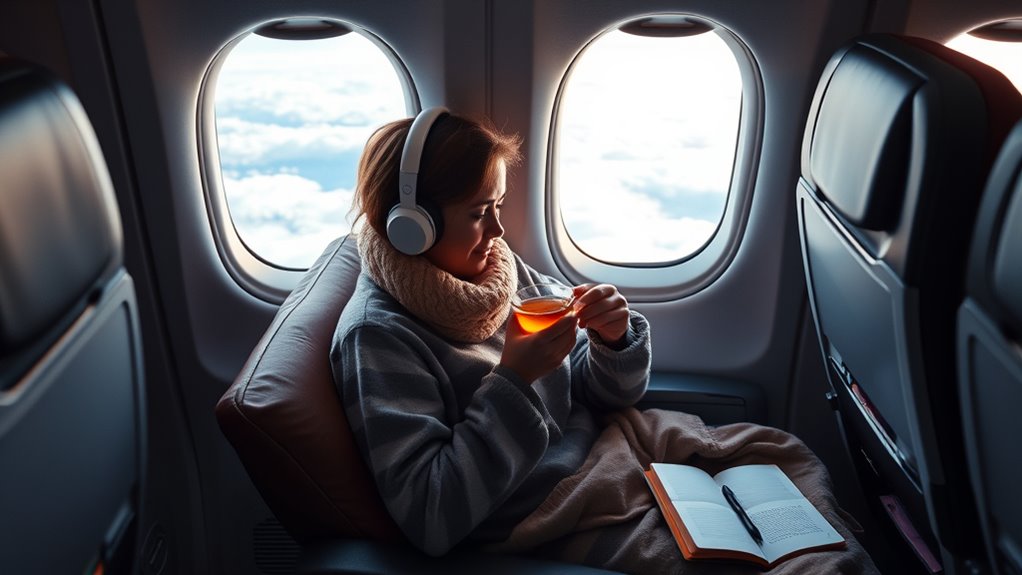To avoid jet lag when visiting your Filipina partner, adjust your sleep schedule gradually before your trip. Book overnight flights and stay hydrated during the flight. Once you arrive, adapt to local meal times and soak up sunlight to reset your internal clock. Engage in light physical activities and keep naps short to stay alert. A few simple habits can make a big difference, so keep going to discover more helpful tips for a smoother shift.
Key Takeaways
- Gradually adjust your sleep schedule before departure by shifting bedtime by 30 minutes each day to align with the Philippines’ time zone.
- Book overnight flights to arrive in the Philippines during the morning or afternoon for a smoother transition.
- Stay hydrated during the flight and limit caffeine and sugar intake to maintain energy levels.
- Upon arrival, spend time outdoors to soak up natural sunlight and realign your internal clock with local time.
- Engage in light physical activities and connect socially to immerse yourself in the local culture and boost your energy.
Schedule Adjustment for Smooth Transition

To make your journey smoother, start adjusting your sleep schedule a few days before you travel. Gradually shift your bedtime by half an hour each day to align with your destination’s time zone. This gradual change helps your body adapt without a major shock upon arrival.
Adjust your meal times and exercise routines too, synchronizing them with local schedules. Consistency is key; maintain these changes in all your daily routines to support your circadian rhythm.
You might also consider taking low-dose melatonin two to three hours before bedtime to further assist with this adjustment. These strategies can greatly ease your adaptation and minimize jet lag, making your visit much more enjoyable.
Effective Flight Strategies to Minimize Jet Lag

Adjusting your sleep schedule is just the beginning of combating jet lag. When booking your flight, consider overnight options; they help align your sleep with your destination’s nighttime.
Aim for flights that arrive in the morning or afternoon, easing your shift. Don’t forget to select a comfortable seat with ample legroom to improve your sleep quality during the journey.
Minimize layovers and opt for shorter flights to reduce travel stress. If possible, choose modern aircraft like the 787 Dreamliner, which offers better cabin conditions.
These strategies can greatly enhance your travel experience and help you arrive feeling more refreshed and ready to enjoy your time with your Filipina partner.
Onboard Habits for Better In-Flight Comfort

Many travelers overlook onboard habits that can greatly enhance comfort during flights.
Prioritize seat comfort by choosing airlines with ergonomic seats and adequate legroom. Staying hydrated is essential, so drink plenty of water and limit caffeine and sugar. Bring nutritious snacks to maintain energy levels, especially if in-flight meals are limited.
Prioritize comfort by selecting airlines with ergonomic seating, staying hydrated, and bringing nutritious snacks for energy.
For better sleep, consider using a memory foam neck pillow and eye mask to block light. Keep stress in check by accessing in-flight Wi-Fi or indulging in calming music. Dress comfortably and elevate your feet to reduce swelling.
Finally, maintain personal hygiene to ease worries about germs. Adopting these habits can transform your flying experience, helping you arrive refreshed and ready to enjoy your time together.
Strategies to Adapt Upon Arrival

As you step off the plane and into a new time zone, embracing local routines can greatly ease your change. Start by adapting to the local sleep schedule immediately; this helps realign your internal clock.
Spend time outdoors to soak up natural sunlight, which regulates your circadian rhythm. Keep your naps short—20 minutes max—to avoid disrupting nighttime sleep. Hydrate well, as water boosts your energy levels.
Opt for light meals to ease digestive discomfort and align your eating patterns with locals. Engage in physical activities to further stabilize your routine.
Finally, connect socially with your partner and explore local activities to immerse yourself in the culture, making adjustment smoother and more enjoyable. Additionally, consider the benefits of energy-efficient models that can help you maintain comfort during your stay.
Post-Arrival Adjustments for Quick Recovery

Embracing local routines sets a solid foundation, but quick recovery hinges on specific post-arrival adjustments.
First, stay hydrated; drink plenty of water, especially during your flight and upon arrival, and avoid dehydrating beverages like alcohol and caffeine.
Next, get ample sunlight to reset your circadian rhythm while keeping your sleep space dark for better rest.
Engage in light physical activity, like stretching or walking, to boost energy without overexerting yourself.
Opt for lighter meals and eat according to local meal times to help your body adjust.
Finally, align your sleep schedule with the local time zone, limit naps, and establish a consistent sleep routine to improve your rest and recovery.
Health and Wellness Tips for Travel

When you’re preparing for travel, prioritizing your health and wellness can make a significant difference in your overall experience. Start by visiting a clinician for necessary vaccinations and medications, and get a letter for any medical needs.
Drink plenty of water to stay hydrated, and choose real food over processed meals to maintain energy. Stretch regularly to ease tension, and consider light exposure adjustments to help with sleep.
On flights, try to sleep when possible and stay active by walking and stretching. Limit caffeine and alcohol to avoid dehydration.
Research local health risks and ascertain you have emergency contact information handy. These simple practices can help you travel healthier and minimize jet lag. Additionally, practicing mindfulness techniques can enhance your self-awareness and help you manage travel-related stress more effectively.
Engaging Activities to Stay Alert and Adjust

To combat jet lag effectively, engaging in various activities can keep you alert and help you adjust to your new environment.
Light physical activity, like walking or jogging, boosts your energy levels.
Explore local culture by visiting landmarks or attending community events; they keep you focused and entertained.
Outdoor adventures, such as hiking or biking, not only energize you but also connect you with nature.
Social interactions, whether meeting locals or joining group tours, enhance mental alertness.
Consider attending workshops or cooking classes to immerse yourself in the local culture.
Finally, challenge your mind with puzzles or strategy games to stay sharp.
Frequently Asked Questions
What Are the Best Flight Routes to the Philippines?
The best flight routes to the Philippines typically land at Manila’s Ninoy Aquino International Airport (MNL).
Major airlines like Philippine Airlines, Cebu Pacific, and AirAsia operate extensive networks.
Popular international connections include flights from Seoul with Asiana Airlines and via Hong Kong with Cathay Pacific.
Once you’re in the country, you can catch domestic flights to popular destinations such as Cebu and Boracay, or use ferries and vans for inter-island travel.
How Can I Manage Jet Lag as a Frequent Traveler?
As you traverse the skies, battling the relentless clock, managing jet lag becomes essential.
Start by adjusting your sleep schedule a few days before departure, aligning it with your destination.
Stay active during flights; stretch and walk around. Hydrate constantly and eat balanced meals to keep your body in sync.
Upon arrival, embrace the local light, and establish a routine.
With these strategies, you’ll conquer jet lag and enjoy your travels fully.
Are There Specific Foods to Avoid Before Flying?
Before flying, you should avoid certain foods to keep discomfort at bay.
Steer clear of fried foods, red meat, and spicy dishes, as they can irritate your stomach. Beans are best left out, too, since they produce gas.
For drinks, limit coffee, alcohol, and carbonated beverages, which can dehydrate you and cause bloating.
Instead, opt for light meals, fresh fruits, and herbal teas to feel your best while traveling.
How Do Time Zone Changes Affect Sleep Patterns?
Think of your body as a finely tuned orchestra; time zone changes can throw it into disarray.
When you travel, your internal clock struggles to keep pace with the new schedule, leading to sleep disturbances. You might feel fatigue, headaches, or changes in appetite as your circadian rhythm gets out of sync.
Adjusting can take about a day per hour of difference, but with some strategies, you can help your body find its rhythm again.
What Are the Signs of Severe Jet Lag?
Severe jet lag can hit you hard, showing signs like extreme fatigue and sleep disturbances.
You might feel light-headed or experience irritability and mood swings.
Physical symptoms can include impaired coordination and digestive issues, like nausea.
Your cognitive function may drop, making it tough to concentrate.
You could also face social challenges due to your low energy and mood.
Recognizing these signs early can help you manage your recovery effectively.
Conclusion
To sum up, avoiding jet lag when visiting your Filipina partner is like tuning a musical instrument before a concert; a little preparation goes a long way. By adjusting your schedule, employing effective flight strategies, and engaging in activities upon arrival, you can harmonize your body’s rhythm with the local time. Remember to prioritize your health and wellness, so you can fully enjoy your time together without the cloud of fatigue hanging over you. Safe travels!









